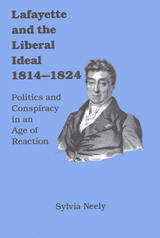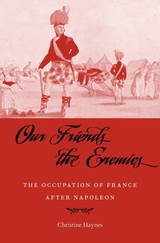

Sylvia Neely provides both the first scholarly study of Lafayette’s life after the French Revolution and a detailed analysis of French politics during the early Restoration.
Lafayette, advocating a liberalism based on the American example, used both legal and illegal means to overturn a conservative government. The personification of liberalism for many of his contemporaries, he and his friends Benjamin Constant, Voyer d’Argenson, and Charles Goyet saw themselves as fighters in an international struggle that set liberalism against the forces of reaction and obscurantism. Although he ultimately failed, Lafayette was convinced that the liberal ideals derived from the Enlightenment and from his personal mentor, George Washington, would prevail.
Neely makes Lafayette’s actions clear by considering seriously the principles that guided his life and by describing the political climate of the early nineteenth century. She discloses previously overlooked features of the revolutions of the 1820s which account for the divisions among the revolutionary groups. She also examines relationships between Lafayette and the prominent writers and thinkers of the period, among them Augustin Thierry, Jeremy Bentham, Lady Morgan, and Frances Wright.

After the defeat and exile of Napoleon and the restoration of the Bourbons, the political climate of France was one of seething unrest, intrigue, and dissent. A clandestine and conspiratorial movement known as the Carbonari, or Charbonnerie, arose in the early 1820's with the aim of overthrowing the monarchy of Louis XVIII. Modeling itself after the Italian Carbonari, this coalition of young French republicans--bonapartists, retired army officers, junior and non-commissioned officers, and leaders of the extreme liberal wing of the Chamber of Deputies--set up cells throughout France, hoping in particular to infiltrate vulnerable army units. Old Hatreds and Young Hopes follows the movement from its beginnings to its ultimate failure, from plots to trials.
Sources of information about secret societies and political conspiracies are always scattered and complex, and often unreliable. Spitzer demonstrates that the secrets of a conspiracy and its place in the broader history of a nation can nevertheless be brought to light by evaluating one kind of evidence against another, by checking and testing government sources, particularly police documents, against such other materials as the memoirs and letters of conspirators and contemporary journalistic accounts. His book is much more than the story of the conspirators. In showing why the conspiracy developed and how it was handled, the author has illuminated the workings of the politicalsystem of the Restoration--the structure and organization of its administration and political police and the operation of political justice in its courts. He also situates the French Carbonari in the history of secret societies and radical movements in the first half of the nineteenth century and works out links with similar groups in other countries.

The Napoleonic wars did not end with Waterloo. That famous battle was just the beginning of a long, complex transition to peace. After a massive invasion of France by more than a million soldiers from across Europe, the Allied powers insisted on a long-term occupation of the country to guarantee that the defeated nation rebuild itself and pay substantial reparations to its conquerors. Our Friends the Enemies provides the first comprehensive history of the post-Napoleonic occupation of France and its innovative approach to peacemaking.
From 1815 to 1818, a multinational force of 150,000 men under the command of the Duke of Wellington occupied northeastern France. From military, political, and cultural perspectives, Christine Haynes reconstructs the experience of the occupiers and the occupied in Paris and across the French countryside. The occupation involved some violence, but it also promoted considerable exchange and reconciliation between the French and their former enemies.
By forcing the restored monarchy to undertake reforms to meet its financial obligations, this early peacekeeping operation played a pivotal role in the economic and political reconstruction of France after twenty-five years of revolution and war. Transforming former European enemies into allies, the mission established Paris as a cosmopolitan capital and foreshadowed efforts at postwar reconstruction in the twentieth century.
READERS
Browse our collection.
PUBLISHERS
See BiblioVault's publisher services.
STUDENT SERVICES
Files for college accessibility offices.
UChicago Accessibility Resources
home | accessibility | search | about | contact us
BiblioVault ® 2001 - 2024
The University of Chicago Press









